How to select a pressure gauge?
14 tips for pressure gauge selection
26 May 2022
Tip 1: Choosing the correct measurement range
The scale range must be chosen so that the measured process pressure is between 1/3 and 2/3 of the scale range. In this area, the gauge reaches its highest accuracy. As a rule of thumb, you can say that the measurement range should be two times larger than the operating pressure.
Choosing a too small measurement range will result in a pressure gauge that is always working in the last third of his scale. This can lead to metal fatigue of the pressure-responsive element because it is under constant high stress. Occasional overpressure is another reason for not choosing a too small measuring range.
The choice of a too large measuring range will, in turn, lead to an indication within the first third of the scale, where the accuracy is reduced.
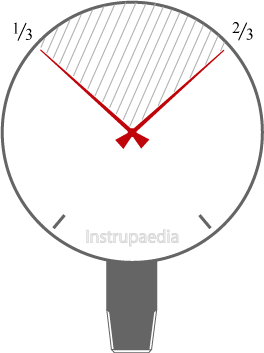
Ensuring a working pressure between 1/3 and 2/3 of the scale range has the effect that pressure gauges according to ASME B40:100 or EN837, will reach their highest measurement accuracy. It also ensures
Tip 2: The scale unit
There are numerous units available for measuring pressure. A small selection from the range of possibilities: bar, mbar, Pa, kPa, MPa, psi, mmH2O, inHg …
The choice of the unit depends, among other things, on the place or country where the gauge is installed.
In Europe, the pressure is very often expressed in bar or mbar, although for the measurement of 3 to 15 psi pneumatic control signals also the unit psi can be used. Pressure gauges with a double scale can be very useful in this case. For example, one scale can be displayed in psi, and the other in bar.
Units such as psi and inHg are widely used in the US while in Asia often the kg/cm², or MPa is used.
Tip 3: The accuracy of the measurement
The accuracy is chosen according to the application and can vary from 0.1 to 5%. If the intention is only to have a rough idea of the pressure at a specific position in the process, it is not necessary to have high accuracy. It is sufficient to choose the accuracy for this purpose between 1.6 and 5% according to the EN837 standard. For manometers designed according to ASME B40.100, this will then be 2/1/2 to 5/5/5.
An example is a pressure gauge at the discharge of a centrifugal pump which only serves to know if the impeller is still intact. Due to an abrasive medium, an impeller may erode, leading to less pressure build-up at the discharge.
The choice is made to an accuracy of between 0.1 and 1% (both according to EN837 as according to ASME B40.100) when it is important to know the exact pressure. Be aware that electronic pressure transmitters can achieve higher accuracies than gauges. If the highest accuracy of a pressure gauge is not enough then you better opt for an electronic pressure transmitter.
Tip 4: The size of the dial
The selection of the dial size depends on the desired accuracy and the application for which the pressure gauge is used.
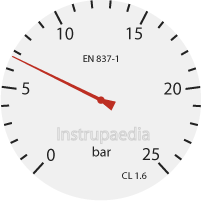
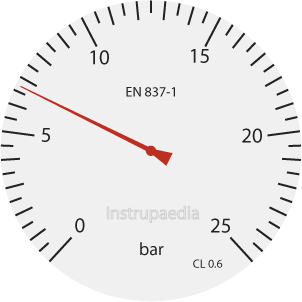
The reason why a pressure gauge is necessary may also have an influence on the dial size. A larger diameter (eg 160mm) can be useful to read the measured pressure from a certain distance. Pressure gauges to be installed in a cabinet or those used to measure inlet, outlet or set pressures of pneumatic control equipment will be mostly selected small (eg 63mm).
Tip 5: The material of the pressure responsive element
The choice of the material depends on the process medium, but also on the magnitude of the pressure to be measured.
If you want to measure the pressure of an aggressive or corrosive medium, it is best to contact the manufacturer of the gauge to select suitable material for the sensing element.
In many cases, stainless steel will be used for the sensing element, but it is not suitable for all kinds of process media. For example, when the fluid contains free chlorine ions, stainless steel will be corroded.
Possible options are a Bourdon tube made of Hastelloy C276 or tantalum, but make sure not to overkill by choosing the highest quality if not absolutely necessary. Some of these special metals can be very expensive, especially for thick-walled Bourdon tubes suitable for the measurement of high pressures. The mass of these tubes may become quite large.
Depending on the pressure to be measured, a chemical seal may be a possible alternative. The Bourdon tube may then be made of a less expensive type of metal while a suitable type of metal, which is resistant to the process medium, is chosen for the diaphragm. Having only the diaphragm made of an expensive metal will result in a cheaper pressure gauge as a whole since the diaphragm has a much lower mass than the Bourdon tube.
Tip 6: The process connection
There are many types of process connections, but they are mainly divided into three categories: threaded, flanged, and clamped connections. The choice of the process connection is sometimes not easy.
From time to time there’s a lot of consideration and knowledge of the process conditions needed in order to make the correct choice.
Screwed connections are cheap, but may not work for all applications, such as for example sanitary applications where the thread is often the cause of a bacterial breeding ground.
For standard pressure gauges with a screwed connection, the Bourdon tube is exposed to the process medium. As a consequence, this kind of pressure gauge cannot be used if the process medium is very viscous, attacks the Bourdon tube, may crystallize or freeze, or contains solid substances which can settle. In all other cases, a threaded connection can be used.
BSP (British Standard Pipe) or NPT (National Pipe Thread) is the standard for threaded connections for most suppliers. NPT is mainly used in the USA and in the oil and gas industry while BSP is mainly used in Europe and the Commonwealth countries.
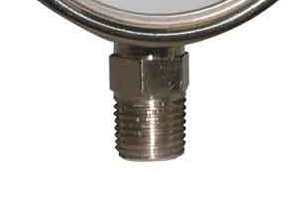

Flanged gauges are always equipped with a diaphragm seal. Also, for flanges, there is a large variety of types and diameters. Often ASME or DIN flanges are used in diameters ranging from 1/2″ to 4″ for ASME flanges and DN15 to DN100 for DIN flanges.
Clamped process connections come in many forms. A few examples include Tri-clamp, Varivent, Neumo BioControl … They are often used in the food and pharmaceutical industries for sanitary applications because they can be removed quickly for cleaning. They are always equipped with a diaphragm seal in order not to have dead zones capable of harboring bacteria.
Tip 7: Connection position
When choosing a pressure gauge you should always know in advance how the mounting will be carried out. Process connections may be at the bottom or back of the gauge. For measurements of pipe pressures, the connection will usually be at the bottom for mounting on the branch pipe. Pressure gauges mounted on pneumatic control equipment or panels usually have a rear connection.
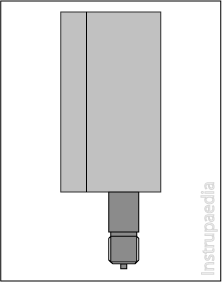
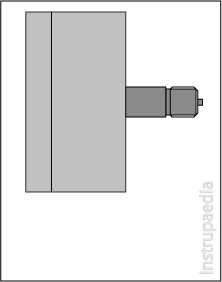
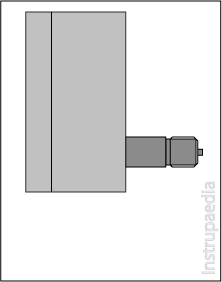
Tip 8: With or without a diaphragm seal
A diaphragm isolates the sensing element from the process medium and is normally used when the process conditions meet one or several of the following properties:
- The medium is highly viscous.
- The medium may crystallize or freeze.
- The medium contains solids that will leave deposits.
- The medium is corrosive and can damage the Bourdon tube.
- The medium is toxic or dangerous. A diaphragm can provide additional protection against the pollution of the environment.
- The temperature of the medium is outside the temperature range of the sensing element.
- The occurrence of high overpressure. Use a diaphragm seal with a pre-formed membrane bed so that, when high pressure occurs, the membrane is pressed against the bed and does not deform.
- Remote reading is necessary. This can be realized by making use of a capillary.
- Sanitary cleanliness is required and dead spaces must be avoided. A flush-mounted diaphragm or an inline seal can be used for this purpose.
A diaphragm prevents the medium from entering the Bourdon tube and solidifying inside of it. If this happens, the last part of the Bourdon tube will no longer sense a change in process pressure causing the deflection of the pointer to be incorrect. Freezing of the medium in the Bourdon tube can cause structural damage to the sensing element.
Tip 9: Vibrations and mechanical shocks
Parts of a plant may be subject to vibration. If in these places the pressure has to be measured, the Bourdon tube will, because of its large overhang, vibrate to the rhythm of the machinery. Although it is better not to install a pressure gauge in these places, it is sometimes impossible to avoid it.
Mild vibrations give rise to small amplitude oscillations of the pointer which can be absorbed by filling the case of a pressure gauge with a liquid. The liquid which is most commonly used for this purpose is glycerin. This ensures damping of the vibrations of the Bourdon tube so that a proper reading is possible.
The liquid filling has the additional advantage of keeping moisture and humidity away from the internal components of the pressure gauge so the risk of corrosion is completely eliminated.
For vibrations of a higher magnitude or mechanical shocks, the fluid filling will not be enough. In this case, the pressure gauge must be installed at a distance, and the connection to the point of measurement will be done by means of a capillary tube and a diaphragm seal.
Tip 10: Pulsating pressure
Fluctuations of the pressure to be measured often give rise to large-amplitude oscillations of the pointer. This frequently occurs when a pressure gauge is mounted on a pump. These fluctuations can best be absorbed by mounting a snubber or a needle valve at the input of the pressure gauge. Both provide an adjustable restriction in the line causing pressure fluctuations to be damped. The result of this attenuation is an indication of the average value of the pulsating pressure.
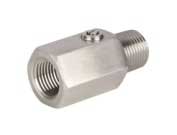
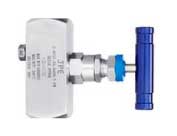
Tip 11: Overpressure
Any pressure above the maximum measuring range means overpressure on the pressure gauge. This gives rise to additional stress in the sensing element and will greatly reduce the service life and the accuracy of the pressure gauge.
To prevent this, you can choose a pressure gauge with a measuring range that is larger than the maximum operating pressure of the installation. This makes that overpressure on the system will be better absorbed by the pressure gauge.
Pressure peaks of a short duration can be countered by mounting a snubber or a needle valve between the pressure gauge and the measuring point.
To safeguard the gauge from long-term overpressures,
Tip 12: Fluid temperature
At temperatures above or below the temperature range of the pressure gauge, the accuracy will strongly decrease, and the possibility of gauge failure may exist. A dry pressure gauge can withstand higher process temperatures than a liquid-filled one. Several methods can be used to protect the pressure gauge against too cold or too hot temperatures.
If steam is the process medium, a siphon can be used which is filled with water as in the pictures below.
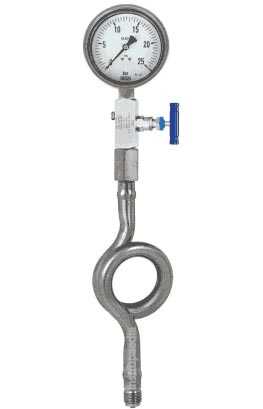
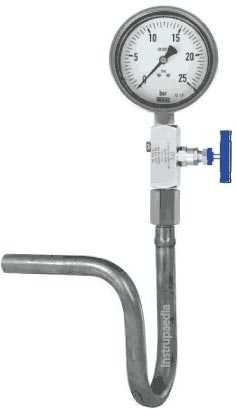
Due to the pressure of the steam, the water is pushed into the Bourdon tube so that it does not operate outside of its temperature range. By condensation of the steam in contact with the water, the siphon will never get empty. Do not forget to fill the siphon with the water before installing it.
A siphon cannot be used when the process medium is hot gas. With a vertical mounting of the pressure gauge, the gas, which is lighter than water, would rise through the water in the siphon. The Bourdon tube would be filled with gas at the same pressure as the process. Initially, the measurement would function but when the process pressure would decrease, the trapped gas in the Bourdon tube would expand and push out the water in the siphon. Over time, the siphon would be empty and the hot gas will penetrate into the Bourdon tube with the failure of the pressure gauge as a result.
Another method to protect the pressure gauge against too high or too low temperatures is the use of a cooling element. For process temperatures above 150 °C (300 °F), it is recommended to use a cooling element combined with a diaphragm seal, and silicone oil filling. The cooling element is mounted between the separation membrane and the pressure gauge and filled with silicone oil. The ambient air flows along the fins of the cooling element and cools or heats the silicon filling oil. This allows a temperature reduction of 93 °C (200 °F) or more, depending on the ambient temperature and the length of the cooling element.

Yet another method is the use of a capillary. Capillaries protect gauges against too high or too low process temperatures. They are always used together with a diaphragm seal. The space behind the diaphragm, including the hollow tube of the capillary, and the Bourdon tube is filled with a liquid. This liquid passes the process pressure unabated to the pressure gauge. The fill fluid should be properly chosen in function of the process temperature.
Capillaries should be as short as possible since temperature changes have an impact on the fluid in the capillary. It’s affecting the accuracy and response time of the pressure gauge.
An additional advantage of capillaries is the possibility to mount the pressure gauge at a distance for remote reading.
If the temperature of a cold process medium falls just outside the temperature range of the pressure gauge, it can be enough to have a slightly longer than normal branch pipe to warm up the process media. The cold medium stands still in the narrow branch pipe and will warm up through heat exchange with the ambient air. Additional heating can be obtained by steam tracing or electrical tracing.
Tip 13: Ambient temperature
The normal ambient temperature range of a pressure gauge is situated between -40 °C and +60 °C (-40 °F and +140 °F) for dry pressure gauges and between -20 °C and +60 °C (-4 °F and +140 °F) for pressure gauges filled with glycerine.
For higher or lower temperatures, pressure gauges should be selected that are resistant to this temperature or the pressure gauge is to be installed at a distance, at a location where the ambient temperature is within the range of the pressure gauge. The pressure gauge is then connected to the measuring point through a capillary tube and a diaphragm seal.
Fluctuations in the ambient temperature do have an influence on the accuracy of the pressure gauge. A temperature change of the pressure gauge of +/- 8 °C (18 °F) rise or fall, gives a measurement error of +0.3% or -0.3% of the measuring range respectively. The reference ambient temperature is 20 °C (70 °F).
According to the EN 837-1 standard, the maximum allowed error of measurement, caused by the temperature effect, will be calculated as follows:
| +/- 0,04 x (t2 – t1) % of the span for Bourdon tube pressure gauges |
| +/- 0,06 x (t2 – t1) % of the span for capsule pressure gauges |
| +/- 0,08 x (t2 – t1) % of the span for diaphragm pressure gauges |
where:
t1 is the reference temperature in degrees Celsius
t2 is the ambient temperature in degrees Celsius
Tip 14: Safety aspect
If a Bourdon tube pressure gauge has been chosen for the application, also the safety design of the gauge should be taken care of. There are four categories to choose from:
| 0 | Pressure gauge without blow-out device |
| S1 | Pressure gauge with blow-out device |
| S2 | Safety pattern pressure gauge without baffle wall |
| S3 | Safety pattern pressure gauge with baffle wall |
The choice of category is made in function of the measuring range, the nominal size of the pressure gauge, the process medium, and whether the case is liquid-filled or not.
More information can be found in the article on the safety design of a pressure gauge.
Bonus: Datasheet template
An easy configurable Excel template is available for specifying pressure gauges. With this pressure gauge datasheet, Bourdon tube pressure gauges, diaphragm pressure gauges, bellows pressure gauges, and capsule pressure gauges can be defined.
Datasheet templates for other types of instruments can be found in the datasheet library.
“How do you select a pressure gauge?”
“Let us know what are the most important selection parameters for your application.”
Related topics
2 Comments
Leave a Comment
Your email address will not be published. Fields marked with * are required.


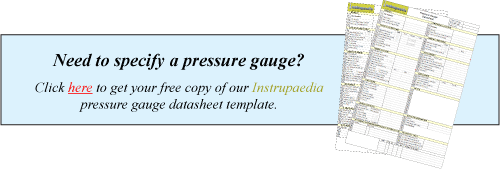

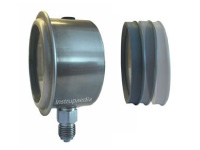
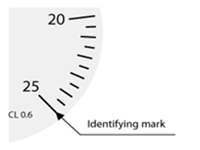

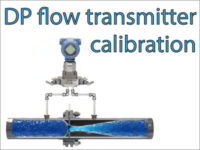
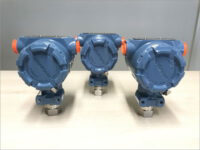
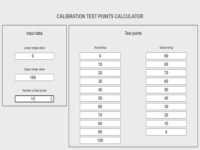
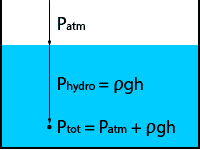
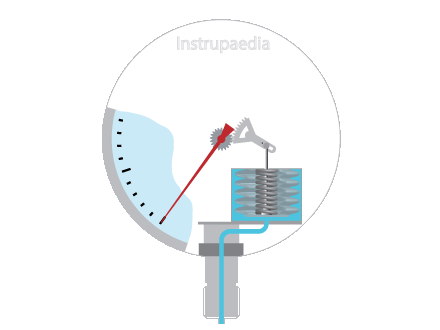
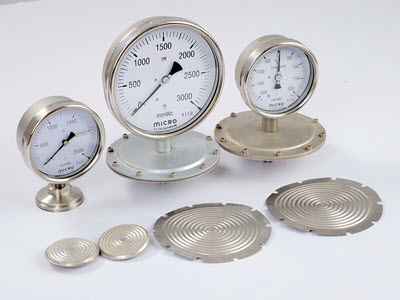

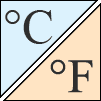

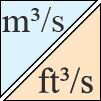


Thanks for your information about the first step of selecting a proper pressure gauge by ensuring that the scale range is between 1/3 and 2/3. My husband’s industry tasked him to look for a quality pressure gauge they can use for a long time. So, I took it upon myself to research about pressure gauges and what they do, thanks!
Glad to have been able to help you.
Thoroughly analyzing the process application, then choosing the correct scale, and taking the appropriate measures to protect the pressure gauge are the most critical factors for a long life of a pressure gauge.